A few days ago, I was able to photograph my first butterfly of the year, a Mourning Cloak Butterfly. The reason the outer edges of its wings are frayed already is because it has been hanging out in Ohio all winter… well, not exactly hanging out. When it’s very cold, this butterfly sneaks into a crack in a tree or some other little nook and hibernates there until it gets warmer. And it doesn’t necessarily wait till spring. Whenever we are having unseasonably warm, winter weather, there is some chance of these butterflies emerging and flitting above the snow.
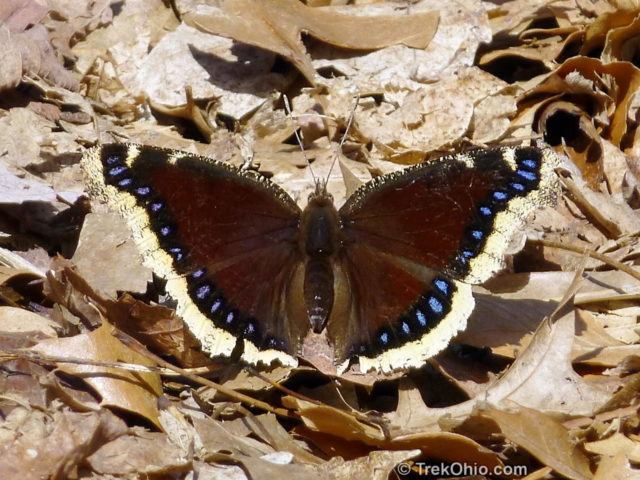
Since very few flowers are blooming in early spring, you might be wondering what this butterfly dines on. It turns out that the Mourning Cloak butterfly isn’t all that interested in nectar. It’s preferred food sources are tree sap, rotting fruit, and animal scat. ![]()
Because it hibernates over the winter, the Mourning Cloak is also one of our longest lived butterflies, maxing out at about ten months. It is believed that the Mourning Cloak hibernates in the summer too, except it’s not actually called “hibernate” if it happens in the summer. Instead it’s called “aestivate”. The thinking is that the Mourning Cloak “aestivates” during the heat of summer and then becomes active and starts eating like crazy in the fall. It needs to pack on enough fat so that it can last till spring.
Check out the feet in the photo below and think about whether there’s anything odd about them.
It looks like it has four feet (three are plainly visible). Now how many feet do insects usually have? … six, right? So what’s the deal with this butterfly?
Actually it does have six feet, but the front two are wee, fuzzy, little things that kind of blend in with its body. Because someone thought that the fuzzy, front feet kind of looked like brushes, such butterflies are said to be “brush-footed.” The Mourning Cloak belongs to the scientific family, Nymphalidae (brush-footed butterflies).
The Mourning cloak lives in Eurasia as well as North America. The name, “Mourning Cloak”, is a translation of its name in German. In Britain it’s known as a “Camberwell Beauty.” It also has an old-fashioned name, “White Petticoat.” That’s my favorite name because it’s easy to see the petticoats while I have no idea what a “mourning cloak” looked like in the era when the butterfly was named; too bad that “White Petticoat” isn’t in current usage.
In early spring the male waits in a sunny, open spot until a female flutters by. Courtship happens mid-air. The females lay all her eggs together on a host plant. Suitable host plants include willow, elm, cottonwood, and hackberry. Although the Mourning Cloak caterpillar below is by itself, typically it would be in a large group with its siblings. This seems to provide a little extra protection for the youngsters because if a predator comes near them, they all bristle together. I imagine this bristling would be more intimidating if done as a large group. If the group eats up the host plant before it’s time to pupate (turn into a pupa), the caterpillars all march off together like a little army looking for another host.
Regardless of the state of the host plant, when it’s time to pupate the caterpillars finally go off in different directions to find a suitable place to turn into a chrysalis-encased pupa (it’s moth caterpillars that end up in cocoons). I learned from North Nature Zine that the general rule is “Don’t pupate where you last pooped!” ![]() Apparently the accumulated waste from the mass of caterpillars might attract predators. Since the pupa are completely defenseless during their transformation into a butterfly, moving away is in their best interest.
Apparently the accumulated waste from the mass of caterpillars might attract predators. Since the pupa are completely defenseless during their transformation into a butterfly, moving away is in their best interest.
I will close with this classic illustration showing the three stages of life for the Mourning Cloak: butterfly, caterpillar and pupa in its chrysalis.
Additional information
- Nymphalis antiopa; this is the scientific name of the Mourning Cloak (published by Wikipedia)
- Mourning Cloak Butterfly (Nymphalis antiopa): Butterflies in the snow! (published by Nature North Zine)
- Common Butterflies and Skippers of Ohio: Field Guide; this is an e-book in PDF format that’s free to download; note that the file is over 82 MB (published by the Ohio Department of Natural Resources)
- The Ohio Lepidopterists
More on Butterflies and Moths
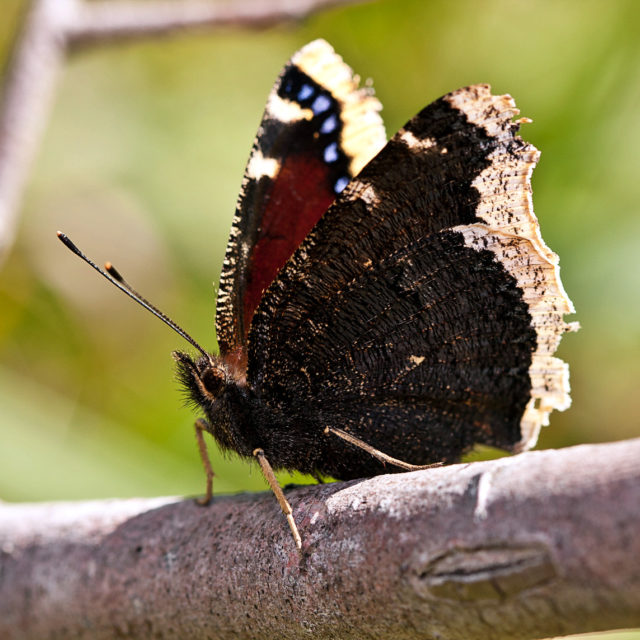
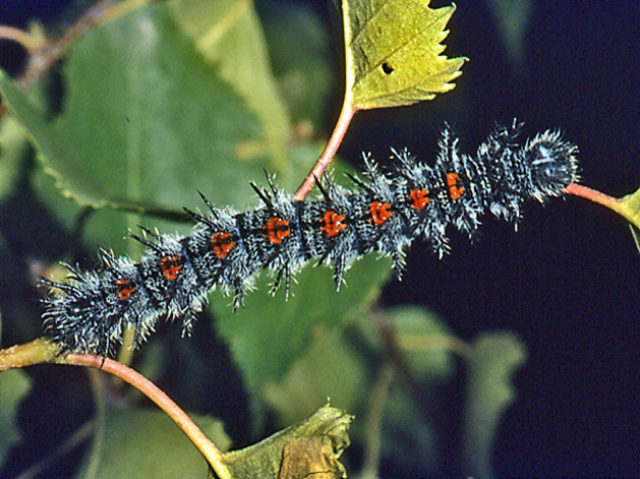
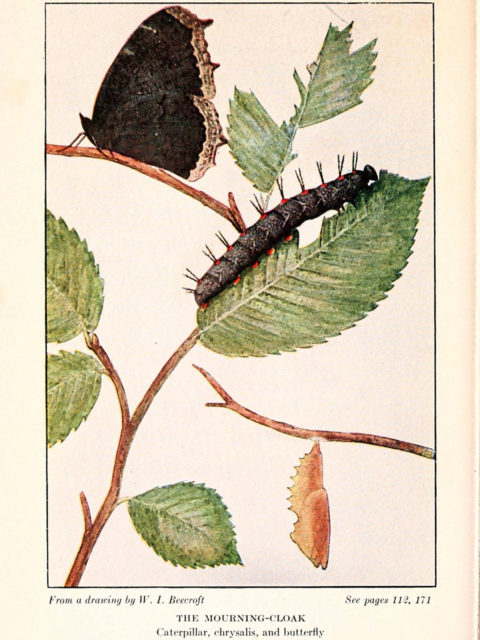
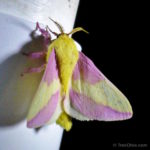
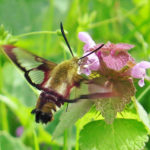
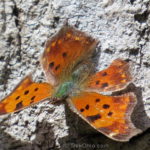
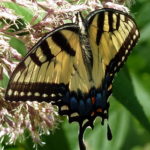
You really captured this little creature! I was wondering if I should try a butterfly feeder in my garden this year or if it would just get overrun by wasps and such.
What a great joy it was to read Your text. Thank You for this information. I have seen it in Finland many times. Our translation in Finnish “Suruvaippa” is the same than that in English..
Thank you, thank you I try and work on some of the methods you suggest. I usually end up taking several shots of one object too, very rarely does the first one come out to my liking. Yes, thank goodness for digital photography.
I was fortunate to see some Sharp-lobed Hepatica today. It is a light-colored, sometimes even white flower. And that reminded me of another technique. For light colored petals, it is sometimes helpful to set the EV to a lower level (say -2/3) and to set your camera to spot focus. Then when you go to take the shot, you want the spot focus to be right on those white petals. That way the details of the flower petals won’t be lost in a flood of white. Here are a couple examples:
Wow, ten months! He’s really an ancient butterfly… I love seeing the older drawings, too. Always fascinating!
FeyGirl, thanks! Check out the Flickr account for the Biodiversity Heritage Library. I just discovered them recently. They’ve already published a huge number of classic illustrations of birds and other wildlife under a Creative Commons license.
Ohhhhh…. I wish I had access to that when I got my new daisy tattoo, hee! I used botanical daisy prints as inspiration. 🙂
THANK you!
Beautiful photographs…….You are one of the best nature photographers out there. Maybe sometime you could give some of us amateurs a few tips on taking photographs with natural subjects. You must sit and wait for the right moment. Every time I try to capture an insect or bird for instance they are gone in an instant.
Patricia, that’s so kind of you to say. Bob and I were just talking about the joys of digital photography today. For instance, that butterfly was kind enough to just land on the trail in front of us. Both my friend and I froze. I did the maximum optical zoom that my camera is capable of (20x), and I then proceeded to take one photo after another till it flitted away. Since I was using my maximum telephoto, I knew that it would be very easy to introduce some jitter which would make the photo blurry. BUT if I take a bunch of shots, the odds are that one won’t be blurry. 😀 If I had to pay for film and developing, I could never afford to do this. But hey, it’s digital, so once I pick my best shot I can throw the others away.
When it comes to taking macro shots of tiny wildflowers, I am fortunate that my point-and-shoot camera has a big sensor … that really helps. Next it’s important to hold the camera very still. It would be impossible to use a tripod because the flowers are so close to the ground. So I improvise a tiny monopod by taking a chopstick along with me. 😀 I can use it in a variety of ways, I can lean the chopstick back at a diagonal and rest the camera on it. Or I can hold the chopstick straight up by making a fist with my left hand, then balance my camera on my fist.
Another trick to doing flower photos is that it is easy to be so focused on the blossom that you don’t realize that you are tilting the horizon. I try to keep the horizon in mind, but it is still easy to tilt because the LCD viewfinder is so close to the ground it is hard to get a good look at it. So if it is tilted, I will use photo-editing software later to un-tilt it. And just like when I am taking the butterfly photo, I will take several shots because I have difficulty framing the photo when the camera is near the ground. But if I try several times, one will usually work out, and I can toss the rest.
Deb, this is a blog I really look forward to recieving. It helps me to be more aware of what is out there. When I get out and about I’ll start to be more watchful and in tune with what is around me.
Thank you, Patrica. The weather if finally getting to be pleasant. If you can get out anytime soon, you’ll start seeing some butterflies and spring flowers. The spring flowers that are found in the woods are teeny, tiny, but worth taking a look at. Here’s what I saw today when on a walk with a friend.